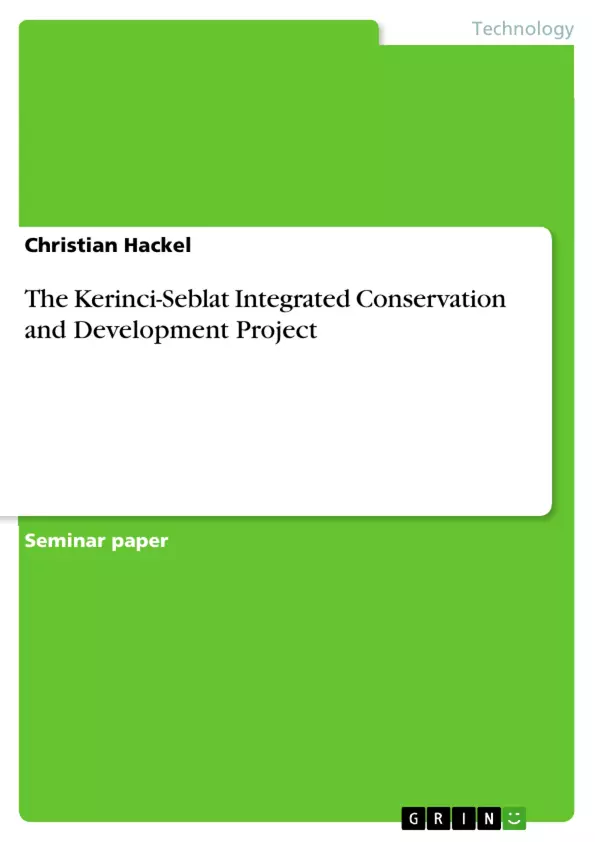Despite comprising only a small part of the earth’s surface, biodiversity hotspots account for a disproportionately high amount of all plant and vertebrae species worldwide. The Kerinci Seblat National Park is located on Sumatra, forming the biggest part of the larger Tropical Rainforest Heritage of Sumatra site, which is on the UNESCO World Heritage List since 2004. It contain 85% of all Sumatran orangutans, 65% of Sumatran tigers, 55% of Sumatran elephants, as well as the only viable population of Sumatran rhinos. Being one of the largest and most important tropical rainforest reserves in Asia the Kerinci Seblat National Park safeguards the largest remaining stock of tropical rainforest in southern Sumatra, covering a total area of about 14000 km2 across four provinces. It holds great potential for long-term conservation of the vast local biodiversity, including many endangered species.
A common objective in conservation practice is to achieve the triple bottom line in the face of inherent trade-offs among social equity, economic return, and conservation outcomes. The Kerinci Seblat Integrated Conservation Development Project sought to address this challenge by applying an inclusive and integrated approach. The intervention was selected as a case study for this essay to explore the root causes for its failure in achieving the intended conservation outcomes. This
understanding is deemed critical for practitioners and decision-makers to design and implement more effective interventions in the future. Starting from an overview of the main environmental and social impacts, the essay provides an assessment of effectiveness and equity of the project, based on a literature research. The last section of this paper outlines implications for future research, policy and practice.
Inhaltsverzeichnis (Table of Contents)
- Introduction
- Environmental Impacts
- Social Impacts
- Assessment of KS-ICDP effectiveness
- Assessment of KS-ICDP equity
Zielsetzung und Themenschwerpunkte (Objectives and Key Themes)
This essay explores the root causes for the failure of the Kerinci Seblat Integrated Conservation and Development Project (KS-ICDP) in achieving intended conservation outcomes. It examines the project's environmental and social impacts, assesses its effectiveness and equity, and outlines implications for future research, policy, and practice.
- The challenge of balancing conservation objectives with social equity and economic development in the context of biodiversity hotspots.
- The role of Payments for Ecosystem Services (PES) in incentivizing sustainable behavior of local communities.
- The importance of integrating local communities as equal stakeholders in conservation initiatives.
- The complexities of land rights and governance in Indonesia.
- The limitations of short-term conservation projects and the need for long-term sustainability.
Zusammenfassung der Kapitel (Chapter Summaries)
- Introduction: The essay introduces the KS-ICDP, highlighting its goal of combining biodiversity conservation with local community development. It emphasizes the importance of understanding the project's failure to inform future interventions.
- Environmental Impacts: This section details the environmental impacts of the KS-ICDP, focusing on the decline in forest cover, poaching, and the extinction of the endemic Schneider's Pitta bird. The essay argues that the project's legacy has had a negative impact on the environment.
- Social Impacts: This chapter discusses the social impacts of the KS-ICDP, focusing on the challenges of engaging local communities in conservation efforts. It highlights the role of the PES approach and the limitations of VCAs in achieving equitable outcomes.
- Assessment of KS-ICDP Effectiveness: This section assesses the effectiveness of the KS-ICDP, evaluating its impact on forest cover loss. The essay concludes that while the project may have had a short-term impact on reducing deforestation, it failed to achieve long-term conservation goals.
Schlüsselwörter (Keywords)
The primary keywords and focus topics include: biodiversity conservation, integrated conservation and development, Payments for Ecosystem Services (PES), Kerinci Seblat National Park (KSNP), Tropical Rainforest Heritage of Sumatra (TRHS), local communities, equity, effectiveness, and sustainability.
- Quote paper
- Christian Hackel (Author), 2024, The Kerinci-Seblat Integrated Conservation and Development Project, Munich, GRIN Verlag, https://www.hausarbeiten.de/document/1459259


